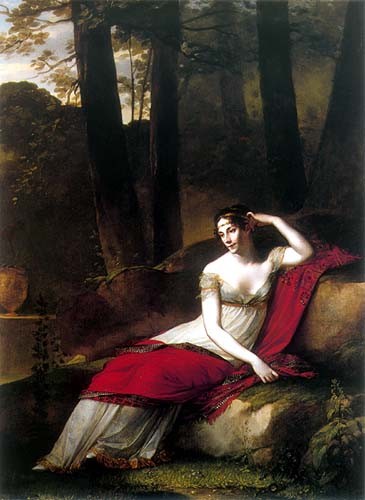Little is known about the commission for this painting. Apparently, the initial idea came from Guillaume Constantin, curator of the Empress’s collections at Malmaison, and from the painter Isabey. Probably begun in 1805, the work was not to be finished until the end of 1809. Prud’hon was most likely slowed up by his work on the painting Justice and Divine Vengeance pursuing Crime. Many sketches are known, which reveal the path the painter took before finally coming to the definitive portrait. Indeed, this picture was to become the most celebrated image of the empress Josephine – an idealised figure, lost in her thoughts.
Many of those who have written on this picture have taken the empress’s pensive mood as a premonition of the divorce of 1809. It is true that she is here shown alone, far from the pomp and ceremony of the court, although her clothing – the white dress embroidered with gold, her red cashmere shawl and the tiaras in her hair – remains deliberately imperial. And despite the fact that subsequent events do seem to have wormed their way into this work, the spirit of the picture is much more one of English portrait painting. The setting of the model in the landscape of the park at Malmaison, the jewel in Empire’s horticultural crown (which Josephine herself had created and which was very dear to her heart) is first and foremost an allusion to the empress’s passion for botany. The atmosphere is also very Rousseau-ian, with nature portrayed as a refuge, a friend, a confident, and also mirror of the soul.
Firmly fixed in the grand tradition of female portraits of the period, this work has the romantic melancholy of Gros’s Christine Boyer, the antique elegance of David’s Madame Récamier and the seductive suavity of Gérard’s Récamier – not forgetting the elegance of the latter’s painting of a languid Josephine reclining on a sofa.
Hung in the empress’s painting gallery at Malmaison, the work figures in the inventory made after Josephine’s death in 1814, and later went to Arenenberg with Queen Hortense. After different adventures, it was hung in Napoleon III’s apartments in the Tuileries, sequestered in September 1870 and definitively handed to the Louvre by a court decision made in 1879.
Karine Huguenaud (tr. P.H.)
October 2005


